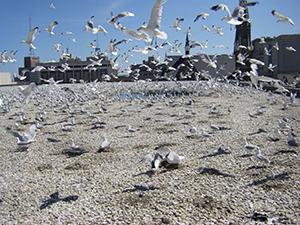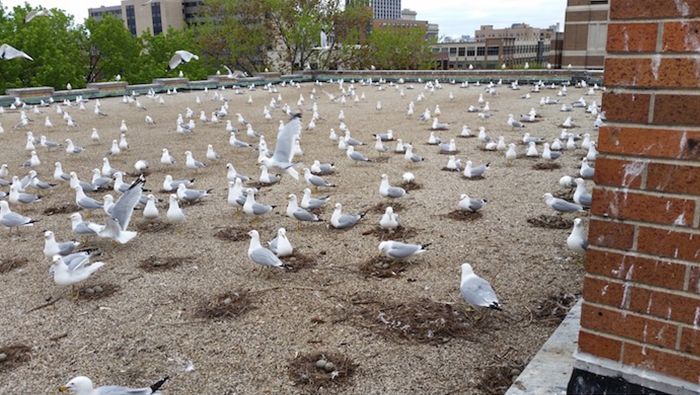What You Need to Know About Egg Depredation Permits & Nuisance Gull Management
Apr 16, 2024
Spring is here – and so are nesting gulls. From May through mid-summer, gulls and their newly hatched chicks can become a massive headache for property owners: they damage structures and assets and pose human health and safety risks.
Because gulls are protected under the federal Migratory Bird Treaty Act, it can be tricky to manage these nuisance birds legally and effectively. Doing so requires careful planning, preferably under the guidance of a skilled service provider like Wild Goose Chase Indy.
Here’s what you need to know about gull management – and a timeline of when and how certain services, from egg depredation to long-term management, should be conducted.
The Risks From Nesting Gulls
Property & Asset Damage
Gulls will make their nests out of just about anything, from woodchips to chicken bones. The accumulation of debris and fecal matter on your property’s roof can:
- Damage the roof itself
- Clog roof runoff drains
- Disrupt rooftop HVAC systems
- Cause rooftop solar assets to underperform
Human Health & Safety Risks
Once gulls establish nests, they become incredibly aggressive and protective, causing safety risks for individuals, including:
- Contractors, maintenance personnel, window washers, HVAC technicians, etc.
- Employees or customers
- The general public
Gull attacks range from swooping down while shrieking, to defecating and vomiting on a perceived threat. Highly aggressive gulls are also capable of knocking people to the ground. This antagonistic behavior intensifies as nesting season wears on, and peaks in the six-week period between when eggs hatch and juveniles take flight.
The escalation of aggression over time underscores the need for proactive management, early into – or preferably prior to – nesting season.

Timeline for Nesting Gull Management
Gull Egg Depredation Application Submission (ASAP, preferably January to February)
Egg depredation and nest removal are highly effective gull management solutions – but require forethought and planning. Because gulls are protected under the Migratory Bird Treaty Act, multiple permits are required from federal and, sometimes, state regulators before your property can manage gulls or their nests.
In Wild Goose Chase Indy’s over 25 years of experience helping customers navigate the federal and state gull egg depredation permitting processes, we’ve found it typically takes 2 to 3 months for a property to obtain the necessary permits.
Harassment Before Nesting (March to April)
From March through April, gulls search for areas to establish nests. Biologically, gulls prefer to nest on properties on which they were born or previously, successfully, nested. Before nesting becomes successful – i.e., a female gull lays eggs – the main goal is to deter gulls from your property. Effective harassment techniques include custom grid systems and handheld or automated lasers.
Grid Systems
Grid systems use suspended lines in the form of a grid to protect large open spaces, courtyards, and flat rooftops from gulls and other soaring birds. The intersecting lines are uncomfortable to land on, so birds learn to perch away from the gridded property.
Fully excluding your rooftop with a grid system will keep gulls away – but is an expensive and involved option. Each grid system is fully customized and uniquely designed to suit the needs of your property.
Bird Lasers
Both automated and handheld lasers may be used to deter gulls from your property. Automated lasers, which must be installed, provide continuous protection and have proven to effectively move large gull colonies off rooftops.
Handheld lasers can provide ad hoc harassment of nuisance gulls. The laser beam can travel over a mile, and, because of the laser’s portable nature, it can cover a large surface area in a short amount of time. Gulls are able to see the entire laser beam in all light conditions. Similar to their perception of trained canines, gulls perceive the laser beam as a threat and, subsequently, leave the property.
Below is a recent video of a handheld laser harassing roosting gulls on a roof in Milwaukee:
Management Strategies During Nesting (May to July)
Beginning in early May, female gulls lay eggs. Once a female gull lays a full clutch (typically 3 eggs) it only takes 22 days of incubation before juveniles arrive. Therefore, it is imperative to act fast before the gull population increases exponentially.
Once a gull has laid eggs on your property, you cannot manage them without first obtaining the necessary federal permits. Should your property manage the nest and eggs without obtaining the federal permit, you can be subject to fines in the thousands of dollars.
Once nesting becomes successful, the main goal is to manage the gull population on your property. Effective techniques include adherence to a gull egg depredation program (if you have a permit) and routine service visits through the duration of nesting season.
Manage Gulls with Wild Goose Chase Indy’s Gull Egg Depredation Program
Wild Goose Chase Indy is an environmental services company that helps properties manage nuisance bird issues through science-based, ecological solutions, including gull egg depredation programs and the deployment of various other harassment techniques. Our team of experts can make your property unattractive to nesting gulls to the degree that they either do not return or return in significantly fewer numbers year over year.
Through our gull egg depredation program, specifically, Wild Goose Chase Indy can help your property manage its nuisance gull population while maintaining regulatory compliance.
Data Management
Wild Goose Chase Indy manages the entire permitting process on your behalf – from application completion and submission to data reporting. Once the permit is obtained, the gull egg depredation service visits can commence. Through our custom app, Wild Goose Chase Indy details all activities undertaken during the nesting season. This ensures all data reporting requirements can be easily met by the reporting deadline.
Service Visits
Wild Goose Chase Indy licensed and experienced service technicians visit your property multiple times throughout the nesting season to manage gull nests and eggs, depending on the size of the gull colonies on your property. During every service visit, our technicians remove all nests and eggs from your property to ensure 100% coverage during each visit.


 0
0
